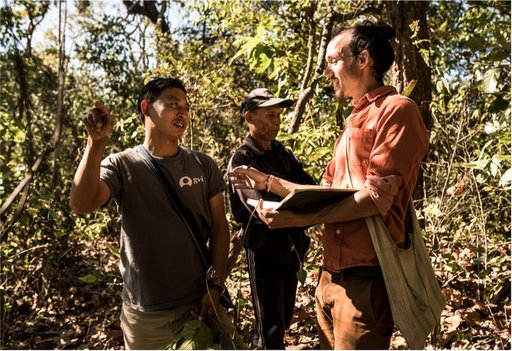




Atruckstopsinfrontofalarge,open-airtent.Elephantsstandundertheshadeoftrees.Mahoutscaretakersoftheelephants,unloadspikyvinesfromthetruck.WeareattheThaiElephantConservationCenter(TECC)innorthernThailand.Thesevineswillbemadeintoherbalmedicineforthe elephants.

TheseelephantsliveattheThaiElephantConservation Center.


Elephantsusetheirtrunkstoliftgrassestotheir mouths.
IfirstcametoTECCin2017asaguideforstudentgroups.Inoticedmanyinterestingthings.TECChadoneofthemostadvancedelephanthospitalsintheworld.Oneofthewaystheytreatedelephantswaswithherbalmedicine.SinceIamanethnobotanist, thisappealedtome.Istudythewaysthatpeopleuseplants.Iknewthatplant-basedmedicineandbiomedicine(or“Western”medicine)aren’toftenfound together.
Next,Inoticedtheelephants’interestintheirherbalmedicine.Iknewthatelephantslovesweetfoods.Sweetcornandsugarcanearefavoritesnackshere.But,elephantswillalsoeatspikyvines,althoughtheyareverybitter.Spikyvinesarepowerfulmedicine.Didtheelephantsknowthiswasmedicine?Ayearandahalflater,IreturnedtoThailandtotrytofind answers.
Thesearepiecesofthespikyvineseatenby elephants.



IworkinthefieldwithaKareninterpreterandamaster healer.
WorkingWithElephants
ElephantshavelivedamongpeopleforthousandsofyearsinThailand.IdecidedtoworkwithagroupofpeoplecalledtheKaren.TheyliveinthemountainsofThailandandtheneighboringcountryof Myanmar.
TheKarenarefamousforworkingwithelephants.Howdidthisbondbegin?Onestorytellsofhowtheelephantwasoriginallyhuman.Thenitlostitshumanity.Itbecameahelperof humankind.
Elephantsplayedaroleinnearlyeverypartoflifehere.Theyknewtheforest.So,theywerethebestwaytotravellongdistances
over land.
Theirstrengthallowedthemtomoveheavyobjectslikelogs.Butascarsandmachinesreplacedthem,theelephants’usefulnesshasfallen.Also,aftercenturiesoftoomuchlogging,forestsbecamethreatened.In1989,loggingwas banned.

Twoelephantsworktogethertomove logs.
Elephantswerenolongerneededforthistypeofwork.Today,mostelephantsareinelephantcampsfor tourists.








